2013 SUBARU BRZ radio
[x] Cancel search: radioPage 41 of 484
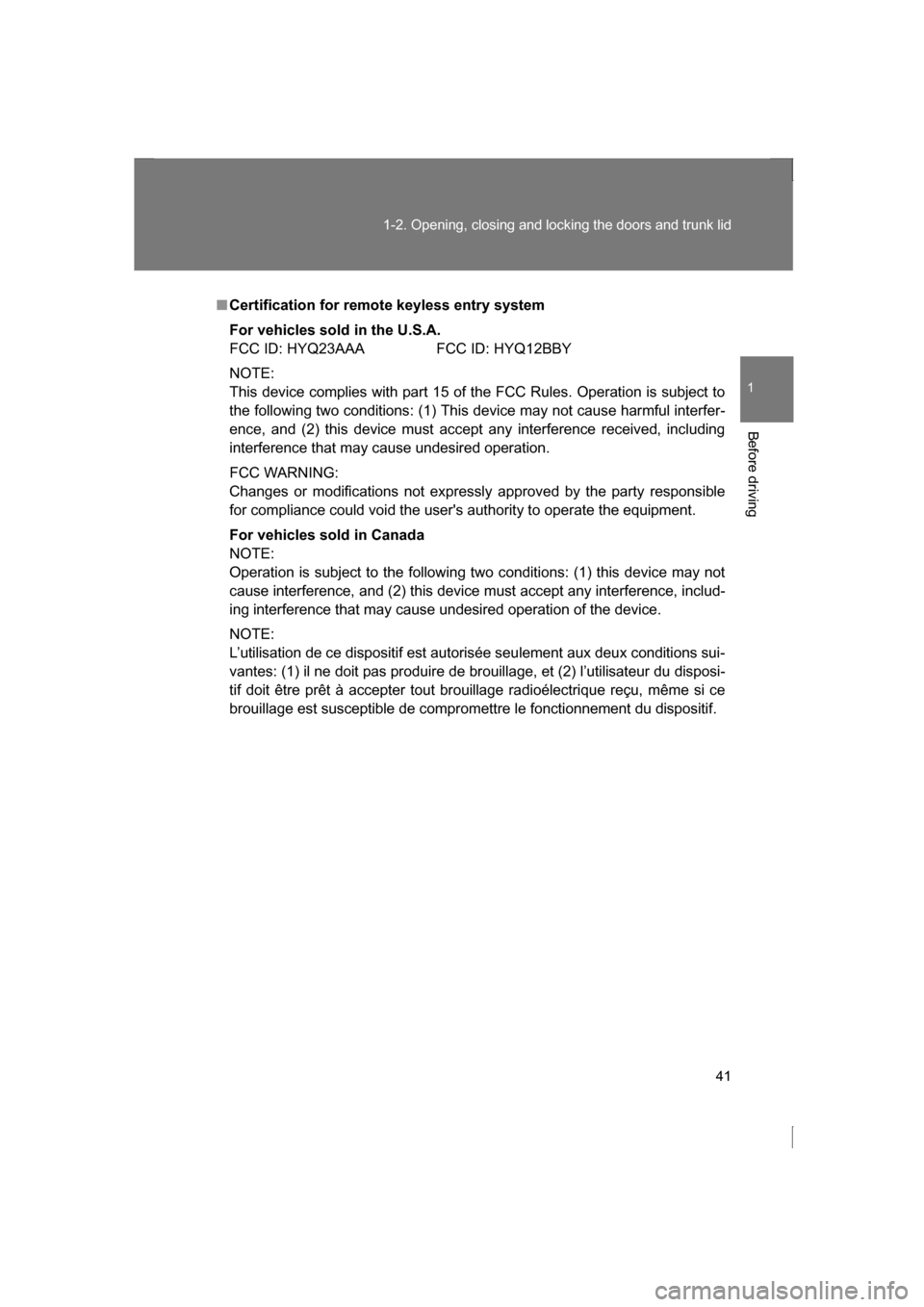
41
1-2. Opening, closing and locking the doors and trunk lid
1
Before driving
■Certification for remote keyless entry system
For vehicles sold in the U.S.A.
FCC ID: HYQ23AAA FCC ID: HYQ12BBY
NOTE:
This device complies with part 15 of the FCC Rules. Operation is subject to
the following two conditions: (1) This device may not cause harmful interfer-
ence, and (2) this device must accept any interference received, including
interference that may cause undesired operation.
FCC WARNING:
Changes or modifications not expressly approved by the party responsible
for compliance could void the user's authority to operate the equipment.
For vehicles sold in Canada
NOTE:
Operation is subject to the following two conditions: (1) this device may not
cause interference, and (2) this device must accept any interference, includ-
ing interference that may cause undesired operation of the device.
NOTE:
L’utilisation de ce dispositif est autorisée seulement aux deux conditions sui-
vantes: (1) il ne doit pas produire de brouillage, et (2) l’utilisateur du disposi-
tif doit être prêt à accepter tout brouillage radioélectrique reçu, même si ce
brouillage est susceptible de compromettre le fonctionnement du dispositif.
Page 47 of 484
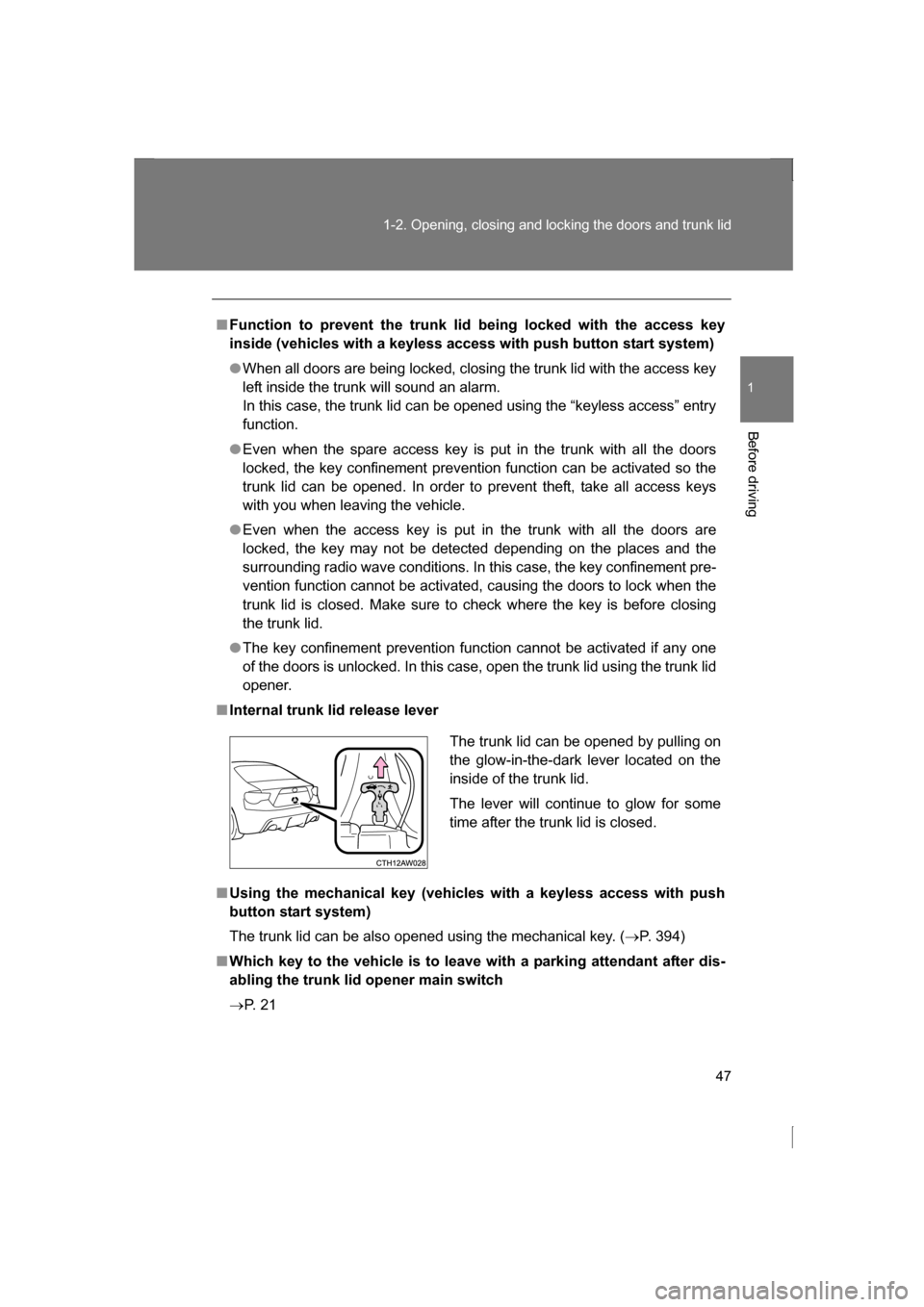
47
1-2. Opening, closing and locking the doors and trunk lid
1
Before driving
■Function to prevent the trunk lid being locked with the access key
inside (vehicles with a keyless access with push button start system)
●When all doors are being locked, closing the trunk lid with the access key
left inside the trunk will sound an alarm.
In this case, the trunk lid can be opened using the “keyless access” entry
function.
●Even when the spare access key is put in the trunk with all the doors
locked, the key confinement prevention function can be activated so the
trunk lid can be opened. In order to prevent theft, take all access keys
with you when leaving the vehicle.
●Even when the access key is put in the trunk with all the doors are
locked, the key may not be detected depending on the places and the
surrounding radio wave conditions. In this case, the key confinement pre-
vention function cannot be activated, causing the doors to lock when the
trunk lid is closed. Make sure to check where the key is before closing
the trunk lid.
●The key confinement prevention function cannot be activated if any one
of the doors is unlocked. In this case, open the trunk lid using the trunk lid
opener.
■Internal trunk lid release lever
■Using the mechanical key (vehicles with a keyless access with push
button start system)
The trunk lid can be also opened using the mechanical key. (→P. 394)
■Which key to the vehicle is to leave with a parking attendant after dis-
abling the trunk lid opener main switch
→ P. 2 1 The trunk lid can be opened by pulling on
the glow-in-the-dark lever located on the
inside of the trunk lid.
The lever will continue to glow for some
time after the trunk lid is closed.
Page 79 of 484
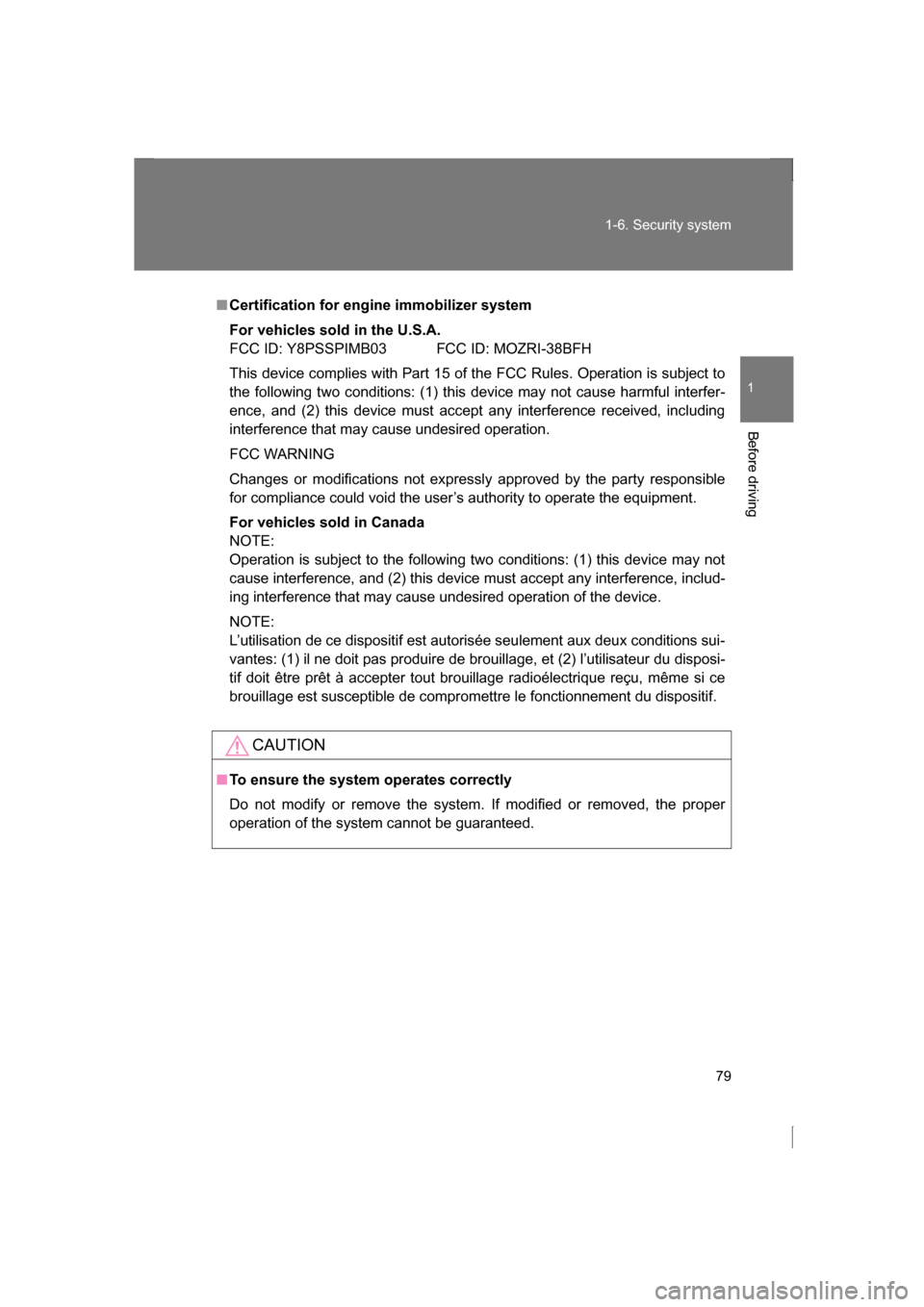
79
1-6. Security system
1
Before driving
■Certification for engine immobilizer system
For vehicles sold in the U.S.A.
FCC ID: Y8PSSPIMB03 FCC ID: MOZRI-38BFH
This device complies with Part 15 of the FCC Rules. Operation is subject to
the following two conditions: (1) this device may not cause harmful interfer-
ence, and (2) this device must accept any interference received, including
interference that may cause undesired operation.
FCC WARNING
Changes or modifications not expressly approved by the party responsible
for compliance could void the user’s authority to operate the equipment.
For vehicles sold in Canada
NOTE:
Operation is subject to the following two conditions: (1) this device may not
cause interference, and (2) this device must accept any interference, includ-
ing interference that may cause undesired operation of the device.
NOTE:
L’utilisation de ce dispositif est autorisée seulement aux deux conditions sui-
vantes: (1) il ne doit pas produire de brouillage, et (2) l’utilisateur du disposi-
tif doit être prêt à accepter tout brouillage radioélectrique reçu, même si ce
brouillage est susceptible de compromettre le fonctionnement du dispositif.
CAUTION
■To ensure the system operates correctly
Do not modify or remove the system. If modified or removed, the proper
operation of the system cannot be guaranteed.
Page 119 of 484
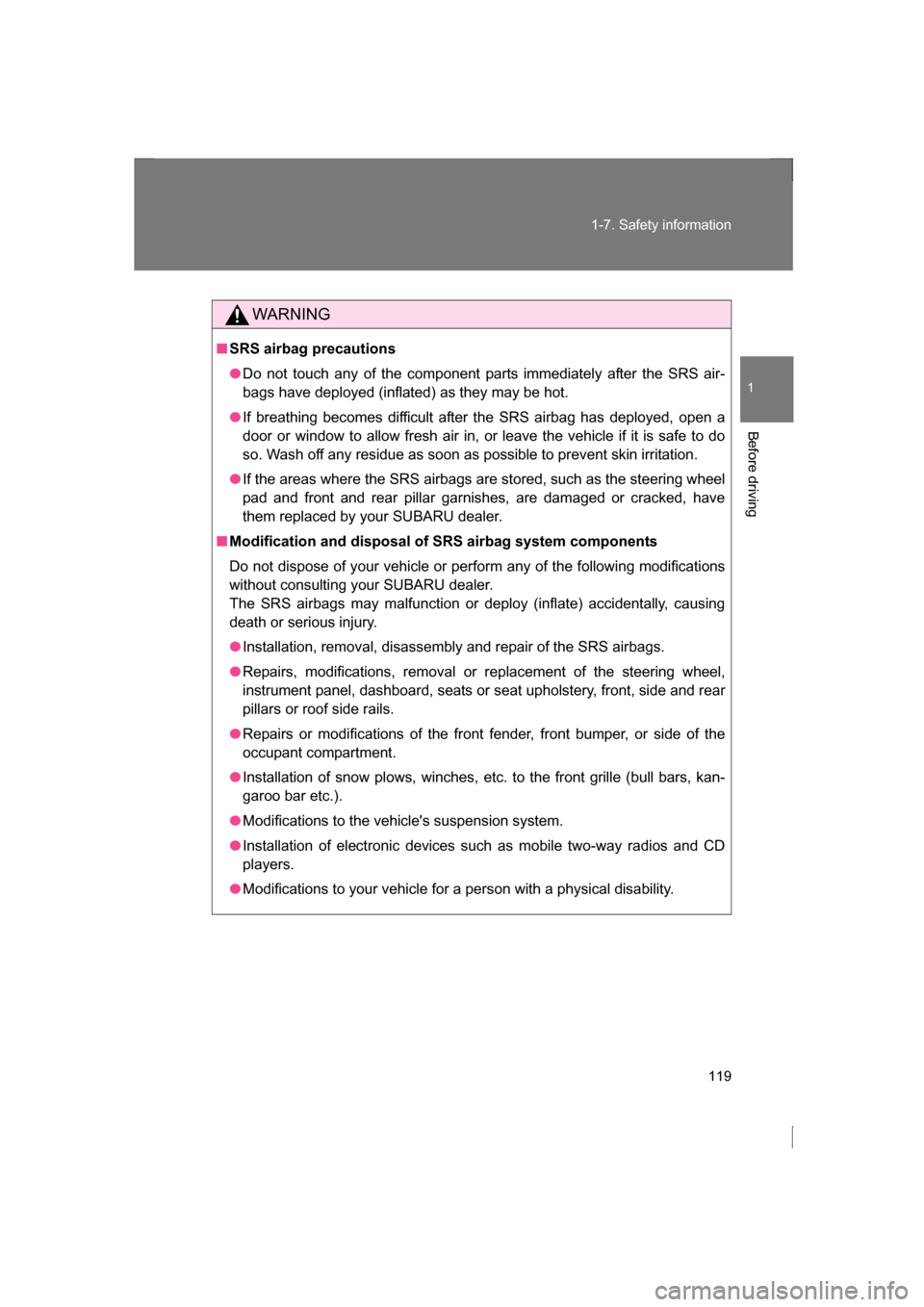
119
1-7. Safety information
1
Before driving
WARNING
■SRS airbag precautions
●Do not touch any of the component parts immediately after the SRS air-
bags have deployed (inflated) as they may be hot.
●If breathing becomes difficult after the SRS airbag has deployed, open a
door or window to allow fresh air in, or leave the vehicle if it is safe to do
so. Wash off any residue as soon as possible to prevent skin irritation.
●If the areas where the SRS airbags are stored, such as the steering wheel
pad and front and rear pillar garnishes, are damaged or cracked, have
them replaced by your SUBARU dealer.
■Modification and disposal of SRS airbag system components
Do not dispose of your vehicle or perfo rm any of the following modifications
without consulting your SUBARU dealer.
The SRS airbags may malfunction or deploy (inflate) accidentally, causing
death or serious injury.
●Installation, removal, disassembly and repair of the SRS airbags.
●Repairs, modifications, removal or replacement of the steering wheel,
instrument panel, dashboard, seats or seat upholstery, front, side and rear
pillars or roof side rails.
●Repairs or modifications of the front fender, front bumper, or side of the
occupant compartment.
●Installation of snow plows, winches, etc. to the front grille (bull bars, kan-
garoo bar etc.).
●Modifications to the vehicle's suspension system.
●Installation of electronic devices such as mobile two-way radios and CD
players.
●Modifications to your vehicle for a person with a physical disability.
Page 335 of 484

335
4-3. Do-it-yourself maintenance
4
Maintenance and care
■Instrument panel
FuseAmpereCircuit
1 ECU ACC 10 A Main body ECU, outside rear view
mirrors
2 P/POINT No.2 15 A Power outlet
3 PANEL 10 A Illumination
4 TAIL 10 A Tail lights
5 DRL 10 A Daytime running light system
6 STOP 7.5 A Stop lights
7 OBD 7.5 A On-board diagnosis system
8 HEATER-S 7.5 A Air conditioning system
9 HEATER 10 A Air conditioning system
10 FR FOG LH 10 A Left-hand front fog light
11 FR FOG RH 10 A Right-hand front fog light
12 BK/UP LP 7.5 A Back-up lights
13 ECU IG1 10 A ABS, electric power steering
14 AM1 7.5 A Starting system
15 AMP 15 A
16 AT UNIT 15 A Transmission
17 GAUGE 7.5 A Gauge and meters, keyless access
with push button start system
18 ECU IG2 10 A Engine control unit
19 SEAT HTR LH 10 A Left-hand seat heater
20 SEAT HTR RH 10 A Right-hand seat heater
21 RADIO 7.5 A
22 P/POINT No.1 15 A Power outlet
Page 370 of 484
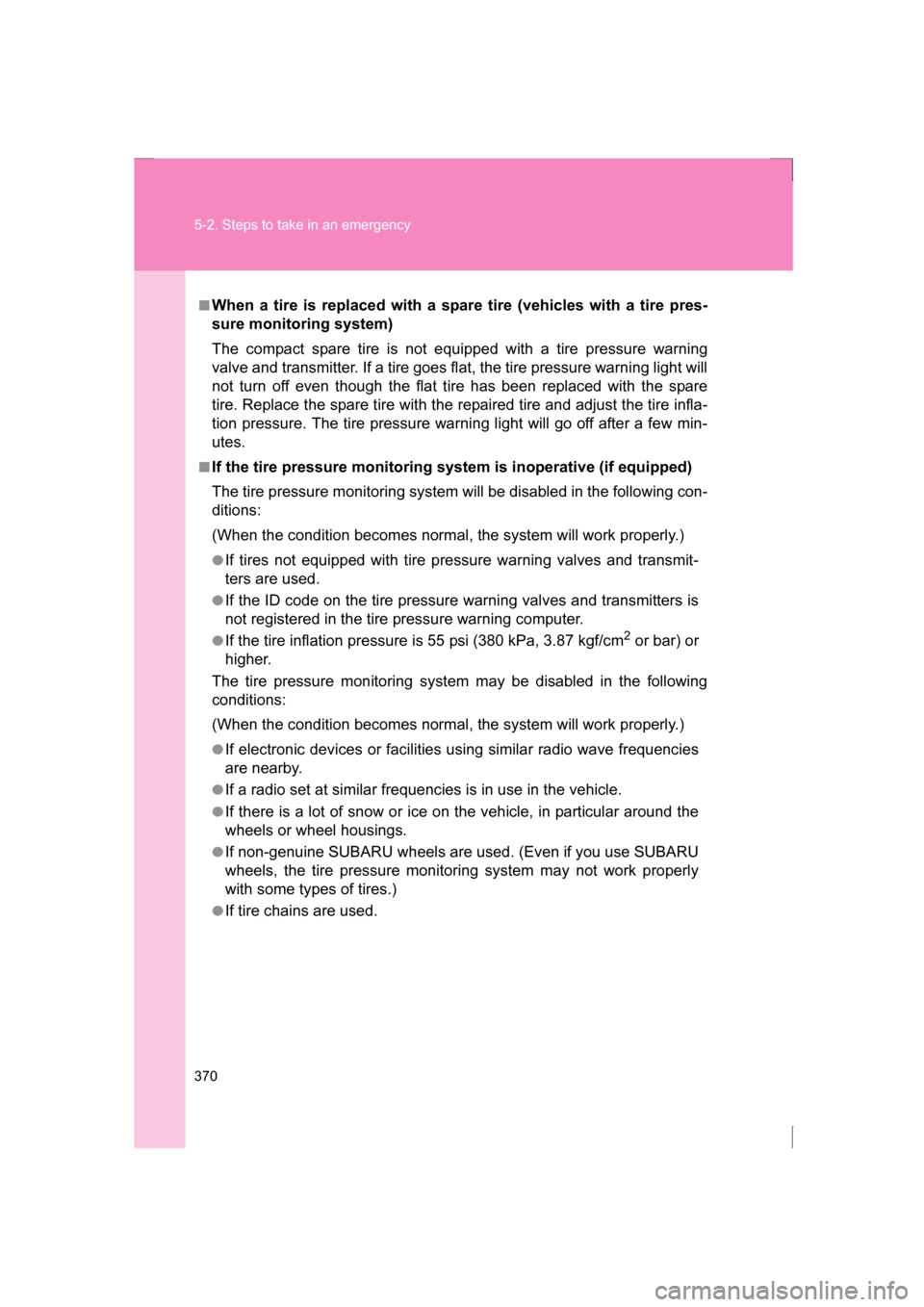
370
5-2. Steps to take in an emergency
■When a tire is replaced with a spare tire (vehicles with a tire pres-
sure monitoring system)
The compact spare tire is not equipped with a tire pressure warning
valve and transmitter. If a tire goes flat, the tire pressure warning light will
not turn off even though the flat tire has been replaced with the spare
tire. Replace the spare tire with the repaired tire and adjust the tire infla-
tion pressure. The tire pressure warning light will go off after a few min-
utes.
■If the tire pressure monitoring system is inoperative (if equipped)
The tire pressure monitoring system will be disabled in the following con-
ditions:
(When the condition becomes normal, the system will work properly.)
●If tires not equipped with tire pressure warning valves and transmit-
ters are used.
●If the ID code on the tire pressure warning valves and transmitters is
not registered in the tire pressure warning computer.
●If the tire inflation pressure is 55 psi (380 kPa, 3.87 kgf/cm 2
or bar) or
higher.
The tire pressure monitoring system may be disabled in the following
conditions:
(When the condition becomes normal, the system will work properly.)
●If electronic devices or facilities using similar radio wave frequencies
are nearby.
●If a radio set at similar frequencies is in use in the vehicle.
●If there is a lot of snow or ice on the vehicle, in particular around the
wheels or wheel housings.
●If non-genuine SUBARU wheels are used. (Even if you use SUBARU
wheels, the tire pressure monitoring system may not work properly
with some types of tires.)
●If tire chains are used.
Page 432 of 484
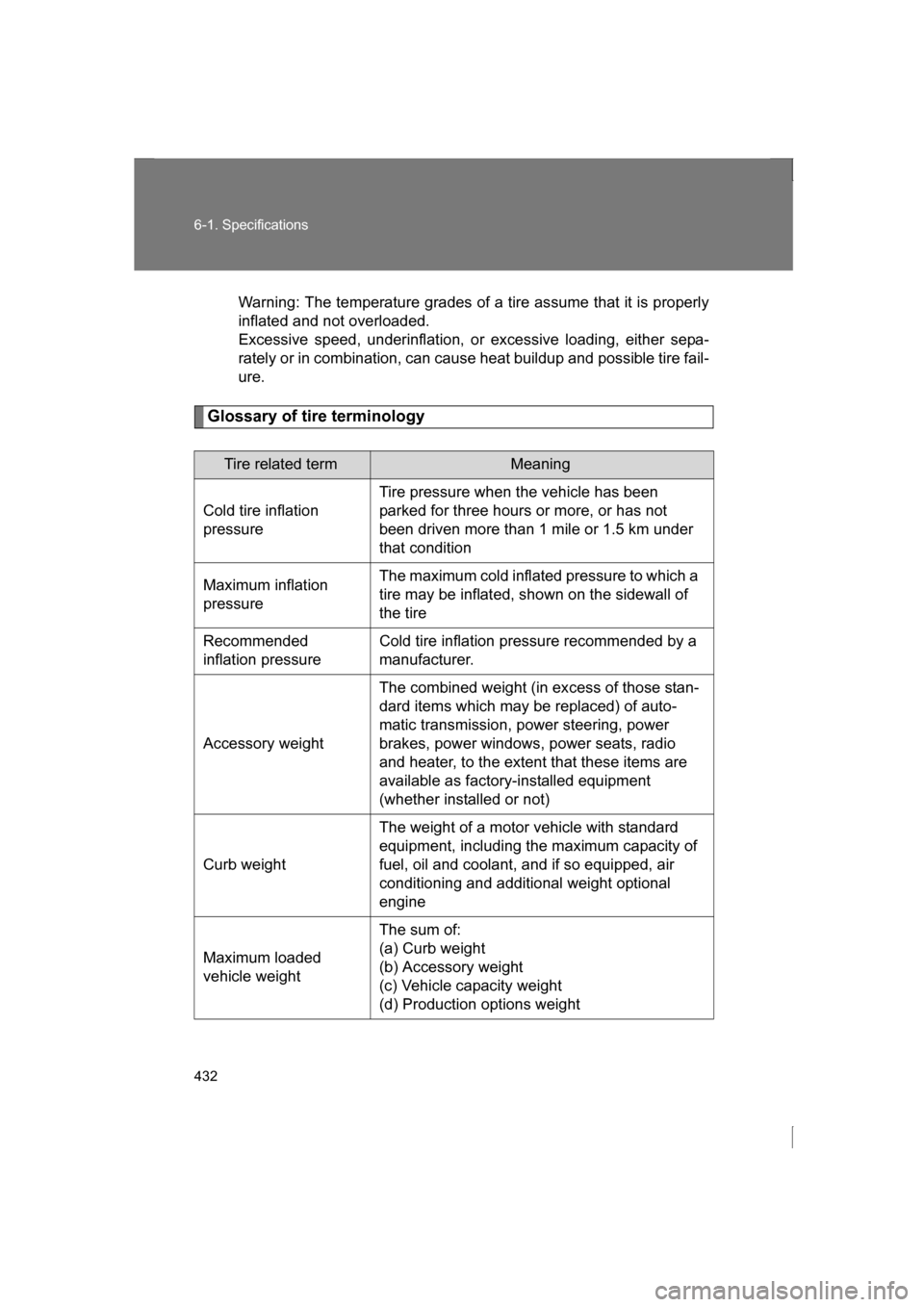
432
6-1. Specifications
Warning: The temperature grades of a tire assume that it is properly
inflated and not overloaded.
Excessive speed, underinflation, or excessive loading, either sepa-
rately or in combination, can cause heat buildup and possible tire fail-
ure.
Glossary of tire terminology
Tire related termMeaning
Cold tire inflation
pressure Tire pressure when the vehicle has been
parked for three hours or more, or has not
been driven more than 1 mile or 1.5 km under
that condition
Maximum inflation
pressure The maximum cold inflated pressure to which a
tire may be inflated, shown on the sidewall of
the tire
Recommended
inflation pressure Cold tire inflation pressure recommended by a
manufacturer.
Accessory weight The combined weight (in excess of those stan-
dard items which may be replaced) of auto-
matic transmission, power steering, power
brakes, power windows, power seats, radio
and heater, to the extent that these items are
available as factory-installed equipment
(whether installed or not)
Curb weight The weight of a motor vehicle with standard
equipment, including the maximum capacity of
fuel, oil and coolant, and if so equipped, air
conditioning and additional weight optional
engine
Maximum loaded
vehicle weight The sum of:
(a) Curb weight
(b) Accessory weight
(c) Vehicle capacity weight
(d) Production options weight
Page 465 of 484

465
7
For owners
DANGER
■Modification et mise au rebut des éléments du système d'airbags SRS
Consultez impérativement votre concessionnaire SUBARU si vous avez
besoin d'intervenir sur votre véhicule ou de procéder à l'une des
modifications suivantes.
Les airbags SRS risquent de ne pas fonctionner correctement ou de se
déployer (gonfler) accidentellement, provoquant ainsi des blessures graves,
voire mortelles.
●Installation, dépose, démontage et réparations des airbags SRS.
●Réparations, modifications, démontage ou remplacement du volant, du
tableau de bord, de la planche de bord, des sièges ou de leur garnissage,
des montants avant et arrière ou des rails latéraux de toit, porte, partie
basse de la porte ou de la garniture de porte.
●Réparations ou modifications des ailes avant, du pare-choc avant ou des
flancs de l'habitacle.
●Installation de chasse-neige, de treuils, etc., sur la calandre (pare-buffle,
pare-kangourou, etc.).
●Modification du système de suspension du véhicule.
●Installation d'appareils électroniques, tels qu'un radioémetteur/récepteur
ou d'un lecteur CD.
●Aménagements du véhicule pour une personne atteinte d'un handicap
physique.